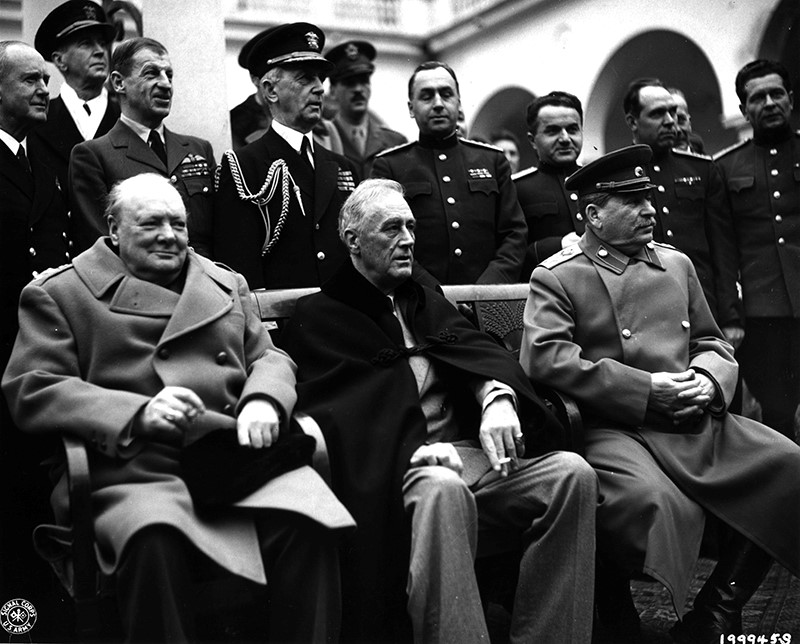4–11 лютого 1945 р. пройшли тристоронні перемовини між лідерами Великої Британії, США та Радянського Союзу – Вінстоном Черчиллем, Франкліном Рузвельтом і Йосипом Сталіним. Місце і терміни зустрічі «Великої трійки» заради безпеки учасників були засекречені аж до її завершення. Газети різних країн подавали суперечливу інформацію. Повідомляли, що зустріч вже триває в Каїрі, потім раптом анонсували, що вона невдовзі розпочнеться в Румунії або «переносили» її на корабель у Чорному морі.
From February 4 to 11, 1945, tripartite negotiations were held between the leaders of Great Britain, the United States, and the Soviet Union – Winston Churchill, Franklin Roosevelt, and Joseph Stalin. The location and timing of the meeting of the “Big Three” were kept secret until its conclusion for the safety of the participants. Newspapers from different countries reported conflicting information. They reported that the meeting was already underway in Cairo, then suddenly announced that it would soon begin in Romania, or they “moved” it to a ship in the Black Sea.
The Crimean Peninsula, liberated from the Germans less than a year ago, was a sad sight: after the deportation of the Crimean Tatars, Armenians, Greeks, and Bulgarians, it was also deserted. At a frantic pace, three magnificent palaces from the tsarist era were “dressed up” on the southern coast. The Americans were settled in Livadia; the British were given Vorontsovsky; the Soviet participants in the negotiations became the residence of the Yusupov Palace. In total, about 700 people gathered in Yalta. All of them witnessed the “shine and poverty” of Russian Soviet reality: the incredible luxury of banquets and the lack of hot water; grandiose architectural ensembles, exquisite interiors, and the dominance of rodents and insects in the apartments.
The Allies declared common goals – to disband the German armed forces, punish war criminals, liquidate the German military industry, compensate for the damage caused by the Nazis, ban Nazism as an ideology and party-political practice. The leaders agreed on the post-war occupation and joint control over Germany. The Allies pledged to hand over all citizens of the USSR, whom they would find in their occupation zones, to the Soviet military administration (as it turned out – for the inevitable massacre).
It was agreed to hold a founding conference to establish the United Nations. The Kremlin insisted that all 16 Soviet republics (at that time the Karelo-Finnish SSR was also part of the USSR) be granted UN membership. In addition to the USSR, Ukraine and Belarus were granted UN membership (completely dependent on Moscow, the republics never gained an independent voice; however, in 1991 their own UN member status would contribute to the speed of international recognition of Ukraine’s independence).
Discussion of other issues on the agenda revealed fundamental differences between the negotiating parties. However, there were factors that could not be ignored; and they were all related to the war. First, the Red Army was several dozen kilometers from Berlin, so the territories of the Soviet zone of interest were largely occupied. Second, shortly after the Wehrmacht surrender, the defeat of the Kwantung Army in the Far East was planned. Therefore, the USA was extremely interested in the USSR entering the war against Japan, so as not to fight alone.
So, Stalin had all the trump cards to resolve the controversial issues in favor of the USSR – and used them to the maximum. Yalta became a kind of symbol of the new redistribution of Europe – the countries of Central and Eastern Europe found themselves behind the “iron curtain”. Its Sovietization took place according to patterns tested by centuries of Russian imperial experience, considering the lessons of the pre-war construction of “terrorist” socialism in a separate country.
If the West offered totalitarian Germany and its ally’s democratic statehood, the USSR, apart from a communist utopia (the project of which had already undergone significant degradation), could offer nothing. Apart from the omnipotence of the punitive system, which ensured the suppression of the national liberation movements of Poles, Ukrainians, and the peoples of the Baltics; Soviet tanks in Berlin (1953), Budapest (1956), and Prague (1968) became symbols of the new “specter of communism,” of Soviet Russian brutal power. There was no long-term perspective for such a situation…
The bipolar world lasted until the end of the 1980s, and then, without a single shot, the countries of Central and Eastern Europe left the “socialist camp,” thereby confirming the fragility of the world order based on the right of the victors over the vanquished. These countries returned to their natural state: a market economy, national statehood, democratic institutions.
Olena Ishchenko

